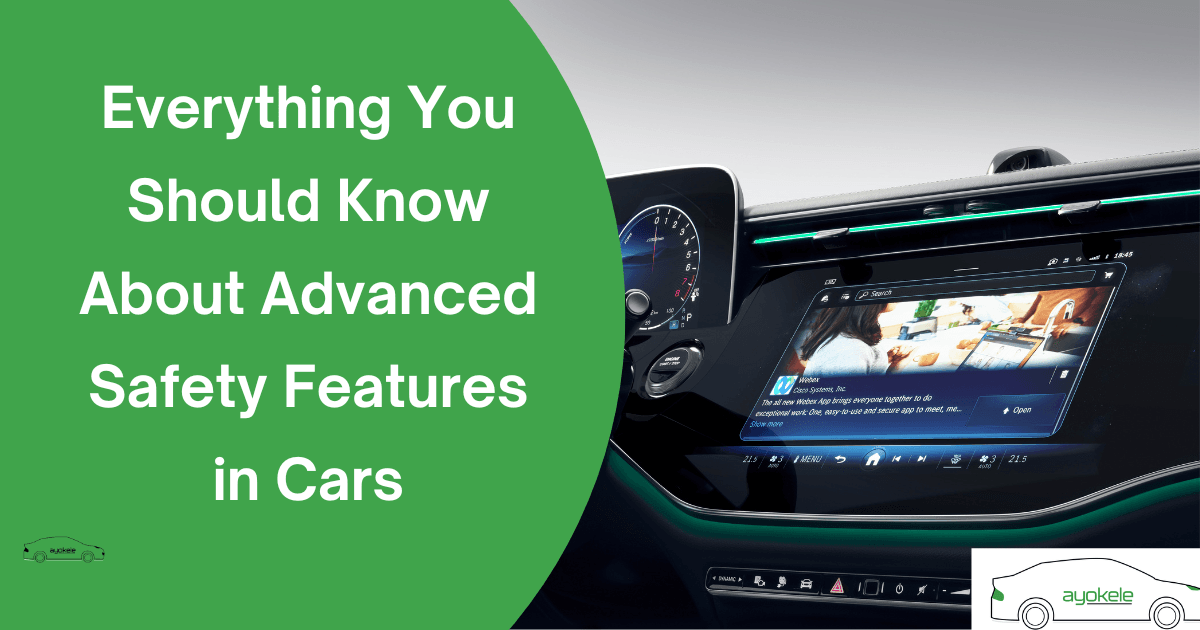Advanced safety features in cars have transformed the way we drive, making vehicles safer and smarter than ever before. These technologies are designed to prevent accidents, protect passengers, and ensure a more confident driving experience. In this article, we’ll explore everything you need to know about advanced safety features in cars. From preventing collisions to assisting with parking, advanced safety features have become an essential consideration when buying a car.
What Are Advanced Safety Features?
Advanced safety features are high-tech systems in modern cars designed to reduce the risk of accidents and enhance driver and passenger safety. Unlike basic safety features such as seatbelts and airbags, advanced safety systems rely on sensors, cameras, and radar technology to monitor road conditions, detect potential hazards, and respond automatically when necessary.
Examples of advanced safety features include Automatic Emergency Braking (AEB), Blind Spot Monitoring (BSM), and Lane-Keeping Assist (LKA). These technologies provide real-time assistance to drivers, such as braking when an obstacle is detected or alerting the driver when the car drifts out of its lane.
Benefits of Advanced Safety Features
1. Reduced Risk of Accidents: One of the biggest benefits of advanced safety features is their ability to prevent accidents before they occur. Features like Automatic Emergency Braking (AEB) detect obstacles or sudden stops and apply brakes automatically to avoid collisions. Similarly, Lane-Keeping Assist (LKA) prevents unintentional lane departures, which are common causes of highway accidents. These proactive systems give drivers an extra layer of protection, especially in situations where quick reaction times are critical.
2. Improved Driving Confidence: Advanced safety features make driving less stressful, especially for new or less experienced drivers. For example, Adaptive Cruise Control (ACC) automatically adjusts your speed to maintain a safe distance from the car ahead, reducing the need for constant manual adjustments on busy roads. Blind Spot Monitoring (BSM) helps drivers switch lanes more confidently by alerting them to vehicles in hard-to-see areas. These features allow drivers to focus more on the road while feeling secure in their vehicle’s ability to assist when needed.
3. Enhanced Convenience and Comfort: Modern safety features go beyond just protection; they also make driving more convenient. Parking Assistance Systems, like rearview cameras and self-parking technology, simplify tight parking situations. Electronic Stability Control (ESC) ensures your car remains stable on slippery or uneven roads, making driving more comfortable in challenging conditions. By integrating safety with convenience, these features elevate the overall driving experience.
Key Advanced Safety Features in Cars
1. Automatic Emergency Braking (AEB): Automatic Emergency Braking (AEB) is designed to prevent or minimize the impact of collisions by automatically applying the brakes when an obstacle is detected. Using radar, cameras, or sensors, the system monitors the road ahead and detects vehicles, pedestrians, or stationary objects. If the driver doesn’t react quickly enough, the system intervenes by braking to reduce the chances of a crash.
AEB can also be effective at higher speeds, such as on highways, where it helps in reducing the severity of rear-end collisions. It works hand-in-hand with other systems like forward collision warnings to ensure a more comprehensive safety setup. As one of the most crucial advanced safety features, AEB has become a standard in many modern vehicles, helping to save lives and reduce repair costs.
2. Lane-Keeping Assist (LKA) and Lane Departure Warning (LDW): Lane-Keeping Assistance (LKA) and Lane Departure Warning (LDW) are systems designed to prevent unintentional lane drifting, a common cause of accidents on highways. Lane-Keeping Assist actively steers the car back into its lane if it begins to drift without a turn signal. Meanwhile, Lane Departure Warning alerts the driver with audible or visual warnings when the car starts to veer out of its lane.
These features are particularly useful during long-distance driving or when driver fatigue sets in. They work seamlessly to ensure the car stays safely within its intended path, minimizing the risk of collisions caused by distracted driving or fatigue.
3. Blind Spot Monitoring (BSM): Blind Spot Monitoring (BSM) helps drivers detect vehicles in their blind spots, areas that are difficult to see using mirrors alone. This system uses sensors or cameras to monitor the sides and rear of the car. When a vehicle enters the blind spot, the system provides a visual or audible alert, helping the driver make safer lane changes.
Blind Spot Monitoring is especially valuable in heavy traffic or on highways, where vehicles can appear suddenly in adjacent lanes. It’s a simple yet effective technology that has become a must-have in many modern vehicles.
4. Adaptive Cruise Control (ACC): Adaptive Cruise Control (ACC) goes beyond traditional cruise control by maintaining a safe distance from the vehicle ahead. Using radar and sensors, ACC automatically adjusts your car’s speed to match the flow of traffic. If the car in front slows down, the system reduces your speed, and when the road clears, it accelerates back to the set cruising speed.
This feature is particularly helpful during long highway drives, as it reduces the need for constant manual adjustments and minimizes driver fatigue. ACC also enhances safety by preventing tailgating and reducing the chances of rear-end collisions.
5. Electronic Stability Control (ESC): Electronic Stability Control (ESC) helps drivers maintain control of their vehicle during slippery or uneven road conditions. The system uses sensors to monitor the car’s movement and detects when it begins to skid or lose traction.
This feature is especially crucial in wet or icy conditions, where loss of control is more likely. ESC not only enhances safety but also boosts driver confidence, as it provides additional support during challenging driving situations. In many countries, ESC is now a mandatory feature in new vehicles, emphasizing its importance in preventing accidents.
6. Parking Assistance Systems: Parking assistance systems make parking easier and safer by using sensors, cameras, and automation. Features like rearview cameras provide a clear view of what’s behind the car, while parking sensors alert the driver to obstacles in tight spaces.
These systems are particularly useful in urban areas, where parking can be tricky and spaces are limited. Parking assistance technology adds convenience while enhancing safety for both drivers and pedestrians.
The Role of Artificial Intelligence in Car Safety
Artificial Intelligence (AI) plays a transformative role in enhancing car safety by enabling real-time decision-making and predictive measures. AI-powered systems, such as adaptive cruise control and collision avoidance, analyze vast amounts of data from sensors and cameras to assess the driving environment. These systems react instantly to potential hazards, offering timely interventions that can prevent accidents and save lives. For instance, AI can detect sudden obstacles, adjust speed, or even take control in emergencies to avoid collisions.
Machine learning, a subset of AI, further enhances safety by continuously improving system performance based on past data. Predictive safety measures, like anticipating driver behavior or identifying high-risk situations, allow vehicles to adapt to various conditions effectively. This constant learning process not only makes current safety systems smarter but also prepares them for more complex scenarios, such as crowded urban traffic or adverse weather conditions.
The integration of AI in autonomous driving represents the pinnacle of innovation in car safety. Self-driving cars utilize AI to navigate roads, obey traffic laws, and interact with other vehicles and pedestrians, aiming to eliminate human error—a leading cause of accidents. While challenges like regulatory approval and technical limitations remain, AI-driven automation holds immense potential for creating safer roads and reshaping the future of transportation.
How to Choose a Car with the Best Safety Features
1. Research Safety Ratings: The first step to choosing a car with advanced safety features is to research its safety ratings. Organizations like the National Highway Traffic Safety Administration (NHTSA) and the Insurance Institute for Highway Safety (IIHS) provide comprehensive crash-test ratings for most vehicles.
Online reviews and user feedback are also helpful in understanding how reliable the car’s safety features are during real-life driving situations.
2. Prioritize Features Based on Your Needs: Not all advanced safety features are equally essential for every driver. For example, if you frequently drive on highways, prioritize cars with Adaptive Cruise Control (ACC) and Lane-Keeping Assist (LKA). For city driving, Automatic Emergency Braking (AEB) and Parking Assistance Systems may be more beneficial.
Consider your driving habits, local road conditions, and the needs of your passengers when selecting features. This approach ensures that the car you choose not only provides maximum safety but also aligns with your lifestyle and driving environment.
FAQs
1. Do advanced safety features increase the cost of a car?
Yes, cars equipped with advanced safety features tend to cost more due to the added technology. However, the benefits of these features, such as reducing the likelihood of accidents and increasing resale value, often outweigh the initial expense.
2. Can safety features reduce my car insurance premium?
In many cases, advanced safety features can lower your car insurance premium. Features like Automatic Emergency Braking (AEB) and Electronic Stability Control (ESC) reduce the risk of accidents, which makes insurers more likely to offer discounts. Check with your provider for eligibility.
3. Are advanced safety features standard in all cars?
Not all cars come with advanced safety features as standard. While some manufacturers include features like Lane-Keeping Assist or Blind Spot Monitoring in their base models, others offer them only in higher trims or as optional packages.
4. Do safety features work in all conditions?
While advanced safety features are highly effective, they may have limitations in extreme weather conditions like heavy rain, snow, or fog. Sensors and cameras can sometimes be obstructed, reducing their accuracy. Regular maintenance ensures optimal performance.
5. Can I add advanced safety features to my car later?
Some advanced safety features, like rearview cameras or parking sensors, can be added to your car as aftermarket upgrades. However, features like Automatic Emergency Braking (AEB) or Lane-Keeping Assistance require complex integrations and are typically only available in factory-installed systems.




